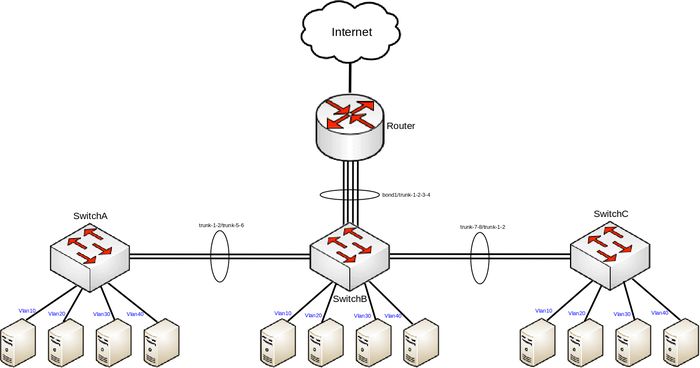Manual:CRS Router
Summary
MikroTik's CRS series devices are powerful switches that also have routing capabilities. In some cases it is sufficient to use the CRS built-in CPU to handle some functions that are meant to be done by a router, not a switch. The CRS series devices can be used as a router and as a switch at the same time, this is useful for networks that focus on internal network throughput and don't require a large throughput to the Internet.
Warning: CRS series devices are NOT designed to handle large amounts of traffic through the CPU, for this reason be very careful when designing your network since large amounts of traffic that are passing through the CPU will overload it. Functions that depend on the CPU (for example, NAT and DHCP) will not work properly when the CPU is overloaded.
In this setup SwitchA is going to be our Switch-Router that will use port based VLANs while SwitchB is going to extend the amount of ports. Switch's ports are going to be divided into 3 groups, each group will tag the ingress traffic (access ports) with the appropriate VLAN ID, while the SFP+ port will be used as a trunk port to forward traffic between switches. In this setup a large throughput between each port is expected (except for the WAN port). This guide is written for CRS326-24G-2S+, but it can be used for any other CRS series device that is capable of running RouterOS.
Port switching
- In case you are using a CRS3xx series device:
All switches in this setup require that all used ports are switched together. Use these commands on SwitchA, SwitchB:
/interface bridge add name=bridge vlan-filtering=yes
There will be different ports assigned to each switch to a bridge since one switch will have a WAN port. Use these commands on SwitchA:
/interface bridge port add bridge=bridge interface=ether2 pvid=1001 add bridge=bridge interface=ether3 pvid=1001 add bridge=bridge interface=ether4 pvid=1001 add bridge=bridge interface=ether5 pvid=1001 add bridge=bridge interface=ether6 pvid=1001 add bridge=bridge interface=ether7 pvid=1001 add bridge=bridge interface=ether8 pvid=1001 add bridge=bridge interface=ether9 pvid=1002 add bridge=bridge interface=ether10 pvid=1002 add bridge=bridge interface=ether11 pvid=1002 add bridge=bridge interface=ether12 pvid=1002 add bridge=bridge interface=ether13 pvid=1002 add bridge=bridge interface=ether14 pvid=1002 add bridge=bridge interface=ether15 pvid=1002 add bridge=bridge interface=ether16 pvid=1002 add bridge=bridge interface=ether17 pvid=1003 add bridge=bridge interface=ether18 pvid=1003 add bridge=bridge interface=ether19 pvid=1003 add bridge=bridge interface=ether20 pvid=1003 add bridge=bridge interface=ether21 pvid=1003 add bridge=bridge interface=ether22 pvid=1003 add bridge=bridge interface=ether23 pvid=1003 add bridge=bridge interface=ether24 pvid=1003 add bridge=bridge interface=sfp-sfpplus1
Since the other switch will not have a WAN port, use these commands on SwitchB:
/interface bridge port add bridge=bridge interface=ether1 pvid=1001 add bridge=bridge interface=ether2 pvid=1001 add bridge=bridge interface=ether3 pvid=1001 add bridge=bridge interface=ether4 pvid=1001 add bridge=bridge interface=ether5 pvid=1001 add bridge=bridge interface=ether6 pvid=1001 add bridge=bridge interface=ether7 pvid=1001 add bridge=bridge interface=ether8 pvid=1001 add bridge=bridge interface=ether9 pvid=1002 add bridge=bridge interface=ether10 pvid=1002 add bridge=bridge interface=ether11 pvid=1002 add bridge=bridge interface=ether12 pvid=1002 add bridge=bridge interface=ether13 pvid=1002 add bridge=bridge interface=ether14 pvid=1002 add bridge=bridge interface=ether15 pvid=1002 add bridge=bridge interface=ether16 pvid=1002 add bridge=bridge interface=ether17 pvid=1003 add bridge=bridge interface=ether18 pvid=1003 add bridge=bridge interface=ether19 pvid=1003 add bridge=bridge interface=ether20 pvid=1003 add bridge=bridge interface=ether21 pvid=1003 add bridge=bridge interface=ether22 pvid=1003 add bridge=bridge interface=ether23 pvid=1003 add bridge=bridge interface=ether24 pvid=1003 add bridge=bridge interface=sfp-sfpplus1
Disable the SFP2+ interface for security reasons (in case it is not being used):
/interface ethernet set [find where name="sfp-sfpplus2"] disabled=yes
